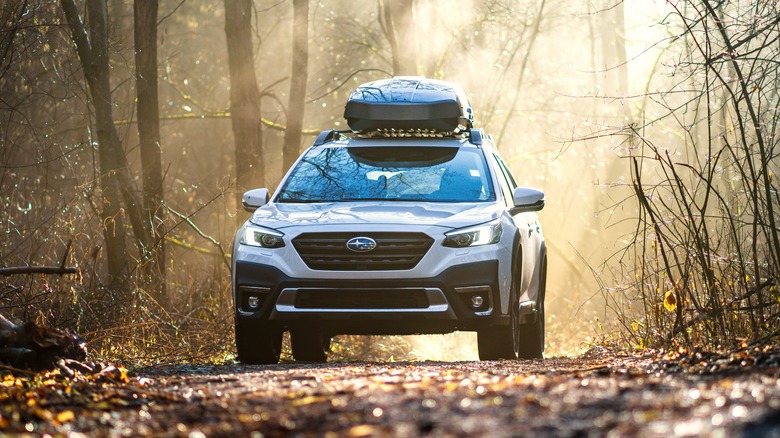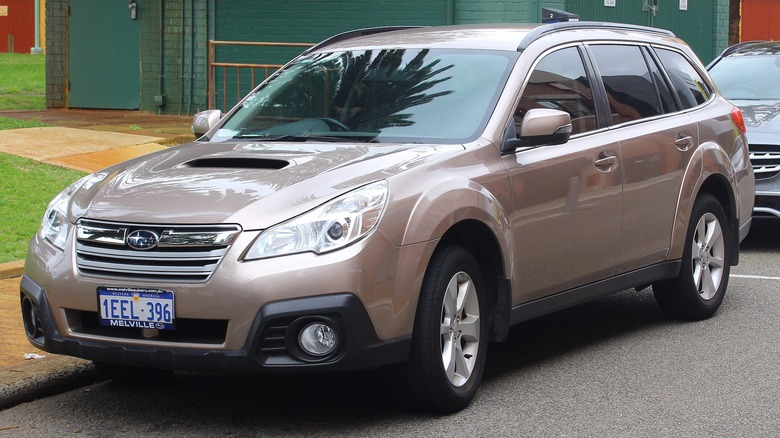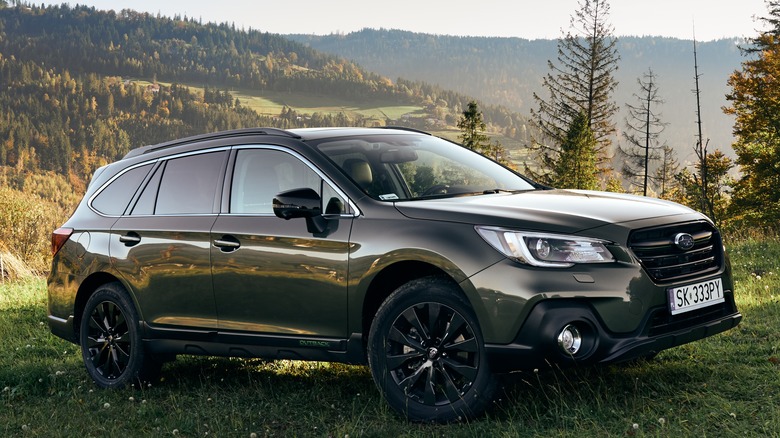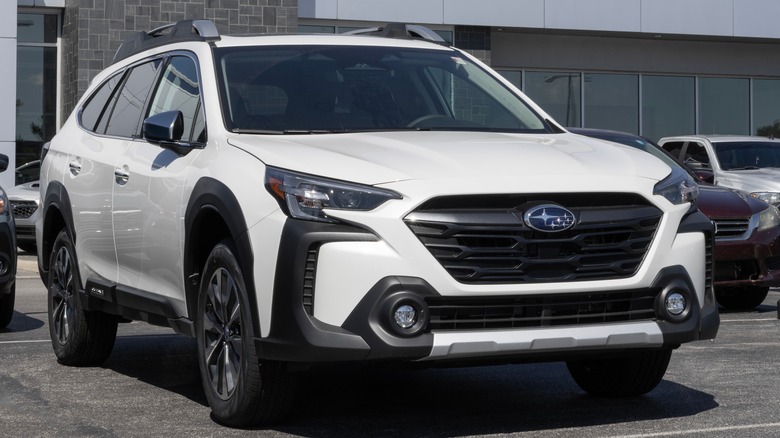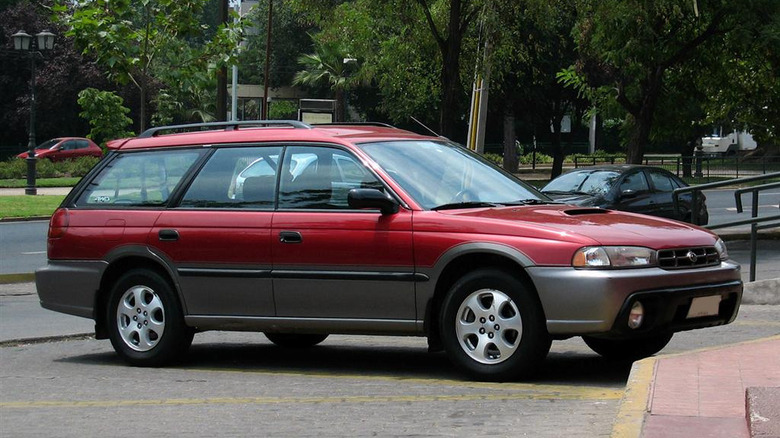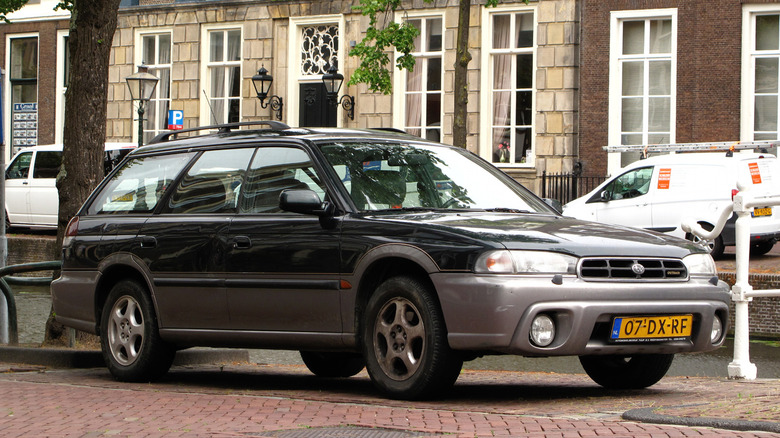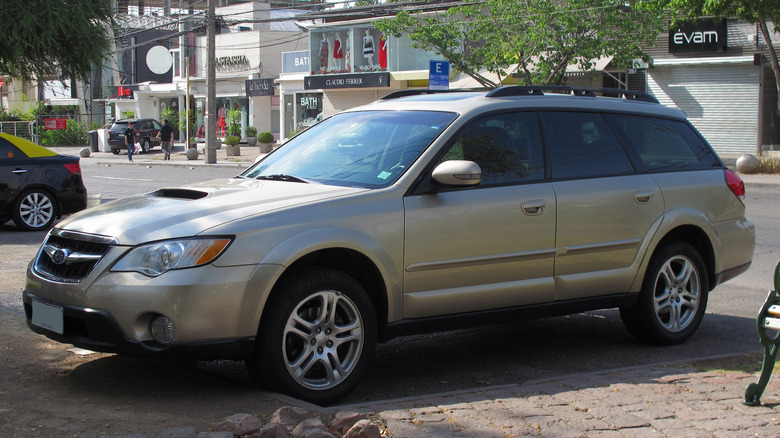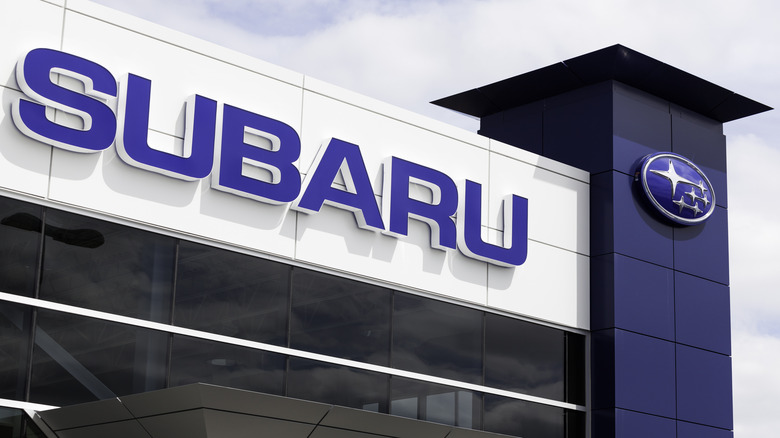Every Generation Of The Subaru Outback, Ranked Least To Most Reliable
Subaru's Outback has had a long and storied journey over the years, starting as a trim level for the Subaru Legacy in the mid-to-late 1990s — memorably promoted by Paul Hogan of "Crocodile Dundee" fame in a series of advertisements — before becoming its own model in 2000. The sport utility wagon — to use Subaru's parlance — has been a prominent part of the crossover SUV landscape ever since, often credited with popularizing the notion of a high-riding and off-road capable station wagon.
Subaru has released six generations of Outback over the years, including the 1990s Legacy Outback. Some aspects have stayed the same — Subaru's commitment to boxer engines, which have featured in all Outbacks, is truly admirable — but many other areas have seen continual improvement and iteration over the years, culminating in the sixth-generation Outback, which debuted in 2020.
However, not every generation has been a hit. Some Outback generations are reliable and well-loved, while others have provided owners with significant headaches over the years. We scoured the NHTSA website to determine the most and least reliable Subaru Outback model years, then combined them into generations. So, whether you're in the market for an Outback or are just curious where your car compares to others, here's a list of Subaru Outback generations ranked according to reliability.
6. Fourth generation (2010 - 2014)
The fourth-generation Subaru Outback debuted in 2009 with improvements like more interior space, a reworked rear suspension, and a revised design that, in the opinion of automotive media at the time, brought the Outback ever closer to crossover territory. Subaru also revised the engine setup, dropping the third-generation Outback's turbo engine in favor of naturally aspirated four- and six-cylinder engines making 170 and 256 hp, respectively.
Unfortunately for Subaru, these engines proved to be quite problematic, with reports of excessive oil consumption on 2011 Outbacks starting to trickle onto the NHTSA website in the late 2010s. The problem eventually got so severe that fourth-gen Outback owners launched a class-action lawsuit against the company in 2014. Subaru settled a couple of years later by offering extended warranties and refunding owners for repair-related costs. Great news for Outback owners in the mid-2010s, but not quite as helpful if you're looking for a used Outback now: they'll be well out of warranty, and there's every chance you'll end up staring at a hefty — $3,500 or more — repair bill if your engine fails.
The engines aren't the only problem, either: 2010 to 2012 Outbacks also have serious transmission problems according to complaints logged by the NHTSA. The 2011 model is the worst-hit, with 210 out of the 632 complaints involving failing transmissions and torque converters. Definitely one of the Subaru models to avoid, then.
5. Fifth generation (2015 - 2019)
Subaru probably hoped that the fifth-generation Outback would leave many of the previous generation's woes behind when it debuted at the 2014 New York International Auto Show with slightly revised engines, all-new Lineartronic CVTs, and updated suspension alongside a range of comfort, infotainment, and design updates. Initial signs were good, with reviews celebrating the Outback's driving experience and car-like nature compared to full-fledged crossovers.
In Subaru's defense, the fifth-gen sport wagon moved past the oil consumption woes that troubled the previous generation, but it was a case of one step forward, two steps back. In its place came in a range of electrical gremlins. One of the most common electrical complaints for this generation involves excessive battery drain: Some 2015 Outback owners had to replace the batteries as much as four times in six years, according to complaints on the NHTSA website.
But while battery drain may be annoying, it's at least not dangerous. That's where the other fifth-gen Outback issues come into the picture. First up is a problem where these cars will randomly accelerate without driver input, which triggered another class action lawsuit in 2020. Subaru claims that the acceleration is due to driver error, but owners believe otherwise — we think you should just avoid wading into this mess altogether. And that's not all: 2016 and 2017 Outbacks have an ongoing recall for steering column-related problems that are severe enough for the NHTSA to declare a "do not drive" advisory.
4. Sixth generation (2020 - present)
The sixth-generation, made-in-U.S. Outback is an almost entirely different vehicle from its predecessors: Built on the new Subaru Global Platform that the company introduced in 2017, Subaru claims that the sixth-gen Outback is much stiffer than the previous model, with better crash protection, improved suspension, and a quieter interior. This current Outback generation is also the first to feature a turbocharged engine since the third generation, with the 2024 Subaru Outback XT rocking a 260-hp turbocharged flat-four under the hood.
Despite all these changes, the fifth generation's electrical faults seem to have continued, at least for 2020. This particular sixth-gen model has over 800 complaints on the NHTSA website, with nearly a third of the complaints involving the electronics. The battery drain issue — often attributed to the car's Data Communication Module — persists, but owners have also reported faults like unresponsive infotainment systems and a wide range of random electrical failures, some of which rendered the car completely immobile.
2021 and newer Outbacks continue to have electrical issues, albeit not quite as severely as the 2020 model — at least, judging by owner complaints logged by the NHTSA. Battery drain is still a problem, but some of the catastrophic failures seem to be somewhat less common. Sadly, these newer Outbacks have a different issue: fragile windscreens. Severe windscreen cracks seem common from 2021 onward; some owners allege that the cracks emerged out of nowhere, while others say that the initial impacts were minor and should not have caused such significant damage.
3. First generation (1995 - 1999)
Subaru's Outback started life as a trim level on the 1995 Subaru Legacy, although it wouldn't get its signature increased ride height until the following year when it arrived alongside a 155-hp 2.5-liter flat-four engine. The 1996 Outback made a bit of a splash when it launched, and contemporary reviews praised the new Subaru's combination of car-like comfort with genuine off-road capabilities, mated to the signature reliability that would eventually earn the Outback a place on our list of the most reliable Subaru models ever.
The mid-to-late 1990s Subaru Legacy models are genuinely well-loved by owners, with many continuing to sing their praises on sites like Kelley Blue Book. Owner complaints on the NHTSA website aren't too bad, either, with no massive deal-breakers that we can see. One of the most common problems is the airbags, primarily to do with them going off due to minor bumps. Subaru issued a recall for this in 1998.
Another common issue for this generation was the head gasket, which failed more regularly than it should have. Some owners report this causing catastrophic damage to the engine, with one owner on the NHTSA website noting that they needed to swap an entirely new motor into their car. It doesn't seem to be a ruinously widespread issue, but you may want to replace the head gasket — alongside all the DIY-able engine maintenance tasks you should perform on a used car, of course.
2. Second generation (2000 - 2004)
The turn of the millennium saw Subaru elevate the Outback to a standalone model, although it continued to share many of the Legacy's underpinnings. The second-generation Outback was larger and came with even more power, courtesy of a well-received 3.0-liter flat-six boxer engine that made 212 hp. Even the old flat-four got a bump in power, putting out 165 hp instead of the 155 hp it made previously.
Subaru had some teething issues during the Outback's first year, with the NHTSA logging many complaints related to the engine and powertrain. Head gasket failures were still an issue — and would continue throughout the generation — but the 2000 Outback also had leaks that caused coolant or gasoline smell to make its way into the cabin. The transmission seems to be another weak point of the 2000 model: some owners report the transmission slipping, while others noted that the automatic gearbox would hesitate — or completely fail — when shifting.
So while we'd perhaps suggest you avoid the 2000 Outback, the rest of the second generation seems to be a good buy. While problems like the aforementioned head gaskets continued to bother some owners, the general number of complaints dropped significantly as the years continued. Subaru seems to have figured out most of the mechanical issues by 2003, although the final two model years had repeated airbag-related recalls that you will want to look at before purchasing.
1. Third generation (2005 - 2009)
Finally, the most reliable of a generally reliable bunch: the third-generation Subaru Outback, which ran from 2005 to 2009. Subaru introduced an all-new platform for the third-gen Outback, with changes that qualified it as a light truck instead of a sedan — all in the name of avoiding new fuel economy and emissions regulations. The third-gen Outback also saw a power increase across the range: the flat-four and flat-six now made 175 and 245 hp, while a new turbo flat-four made 250 hp and 250 lb-ft of torque — just barely missing out on being one of the most powerful boxer engines ever.
Subaru's airbag woes from the final couple of years of the second generation continued into the third generation, with the 2009 model being the worst of this generation. That particular year has 14 recalls on the NHTSA website up to January 2020, with the majority involving the passenger airbag inflator. All third-gen models have had at least one recall due to airbag-related concerns, though. So, while we're naming this the most reliable generation of Outback, it's still not a car you can blindly buy without some preliminary checks.
On the plus side, the third-gen Outbacks generally don't have any catastrophic issues. They're not perfect, admittedly — the 2006 model, for example, seems to have problems with the engine randomly dying — but we don't see any standout concerns. Pay attention to all the important parts of a used car, schedule an inspection with a trusted mechanic, and you should be fine.
Methodology
We based our ranking of Subaru Outbacks primarily on the number of owner complaints for each model on the NHTSA website, which we then collated into generations. While it's not a perfect gauge, we find that the number of owner complaints are a good indicator of problematic cars, though it's also important to consider the nature of the complaints. Some issues — such as drivetrain and safety problems — are much more severe than relatively minor faults such as peeling paint or faulty windows, and can also be much more expensive to repair.
Given our generational focus here, we didn't dive too deeply into manufacturer recalls, as these can vary wildly between model years and don't always represent an entire generation. That said, we tried to highlight any severe recalls, especially ones that are still ongoing at the time of writing. Recalls, even resolved ones, are still an important factor to consider when buying cars, so you shouldn't treat this guide as gospel and do your own research on year-specific recalls before taking the plunge on a used Outback.
While recalled cars should have been fixed, there's still a chance that previous owners of a particular car failed to send theirs in, for whatever reason. So if there are any major recalls, do your due diligence and check whether the issues have been addressed. That doesn't guarantee that you won't have issues, but it'll hopefully help you avoid major headaches down the line.
